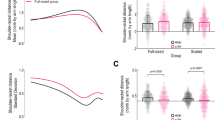Abstract
Stringed instrument bowing is a complex sensorimotor skill, involving fine regulation of bow orientation and motion relative to the string. In this study, we characterize this skill in terms of stabilization of specific bow parameters as well as the underlying use and coordination of the degrees of freedom (DOF) of the right bowing arm. Age-matched samples of 10 advanced cellists and 10 cello novices took part in the study. Kinematic bow movement data were analyzed with respect to task variables suggested by the cello teaching literature: position and orientation of the bow relative to the string, bow velocity, and timing. Joint motion of the bowing arm was analyzed in terms of movement amplitude and inter-joint coordination (principal component analysis). As expected, novices showed poorer control of bowing parameters. In addition, novices differed markedly from advanced players in the use and coordination of the DOF of the bowing arm, with the elbow and wrist showing less overall movement and a reduced proportion of variance explained by the first principal component (PC1). In contrast, larger amounts of shoulder variance were explained by PC1 in novices compared to experts. Our findings support Bernstein’s theory of graded skill acquisition, according to which early stages of motor skill learning are characterized by a “freezing” of movement DOF, while later learning stages exploit the DOF, possibly following a proximal-to-distal sequence, for improved task performance.








Similar content being viewed by others

References
Arutyunyan G, Gurfinkel V, Mirskii M (1969) Organization of movements on execution by man of an exact postural task. Biophysics 14:1103–1107
Baader AP, Kazennikov O, Wiesendanger M (2005) Coordination of bowing and fingering in violin playing. Cogn Brain Res 23:436–443
Bakeman R (2005) Recommended effect size statistics for repeated measures designs. Behav Res Methods 37:379–384
Bernstein N (1967) The co-ordination and regulation of movements. Pergamon Press, Oxford
Bernstein N (1996) On dexterity and its development. In: Latash ML, Turvey MT (eds) Dexterity and its development. Lauwrence Erlbaum, Hillsdale, pp 3–244
Chen J, Woollacott M, Pologe S (2006) Accuracy and underlying mechanisms of shifting movements in cellists. Exp Brain Res 174:467–476
Chen J, Woollacott MH, Pologe S, Moore GP (2008) Pitch and space maps of skilled cellists: accuracy, variability, and error correction. Exp Brain Res 188:493–503
Daffertshofer A, Lamoth CJC, Meijer OG, Beek PJ (2004) PCA in studying coordination and variability: a tutorial. Clin Biomech 19:415–428
Ericsson KA, Krampe RT, Tesch-Römer C (1993) The role of deliberate practice in the acquisition of expert performance. Psychol Rev 100:363
Konczak J, Velden HV, Jaeger L (2009) Learning to play the violin: motor control by freezing, not freeing degrees of freedom. J Mot Behav 41:243–252
Lawrence MA (2011) ez: easy analysis and visualization of factorial experiments. http://CRAN.R-project.org/package=ez. Accessed 2012
Mantel G (1995) Cello technique: principles and forms of movement. Indiana University Press, Bloomington
Müller H, Sternad D (2003) A randomization method for the calculation of covariation in multiple nonlinear relations: illustrated with the example of goal-directed movements. Biol Cybern 89:22–33
Newell KM, Van Emmerik REA (1989) The acquisition of coordination: preliminary analysis of learning to write. Hum Mov Sci 8:17–32
Rab G, Petuskey K, Bagley A (2002) A method for determination of upper extremity kinematics. Gait Posture 15:113–119
Scholz JP, Schöner G (1999) The uncontrolled manifold concept: identifying control variables for a functional task. Exp Brain Res 126:289–306
Southard D, Higgins T (1987) Changing movement patterns: effects of demonstration and practice. Res Q Exerc Sport 58:77–80
Starr W (1996) The Suzuki violinist: a guide for teachers and parents. Birch Tree Group Ltd
R Development Core Team (2008) R: a language and environment for statistical computing. Vienna, Austria. http://www.R-project.org/. Accessed 2012
Vereijken B, Van Emmerik RE, Whiting H, Newell KM (1992) Free(z) ing degrees of freedom in skill acquisition. J Motor Behav 24:133–142
Winold H, Thelen E (1994) Coordination and control in the bow arm movements of highly skilled cellists. Ecol Psychol 6:1–31
Winold H, Thelen E, Feng J (2002) On the rebound. The Strad 514–521
Acknowledgments
We thank Magdalena Koschitzki, Nina Lisofsky, and Zahra Rezaie for their help with manual data processing, and Nina Lisofsky for helpful suggestions on an earlier version of the manuscript. We would also like to thank the reviewers for constructive comments and suggestions.
Conflict of interest
The authors declare that they have no conflict of interest.
Author information
Authors and Affiliations
Corresponding author
Rights and permissions
About this article
Cite this article
Verrel, J., Pologe, S., Manselle, W. et al. Coordination of degrees of freedom and stabilization of task variables in a complex motor skill: expertise-related differences in cello bowing. Exp Brain Res 224, 323–334 (2013). https://doi.org/10.1007/s00221-012-3314-2
Received:
Accepted:
Published:
Issue Date:
DOI: https://doi.org/10.1007/s00221-012-3314-2



